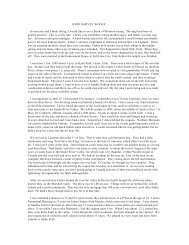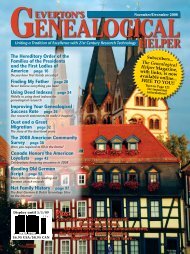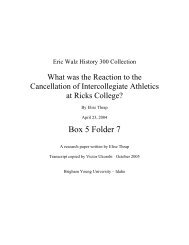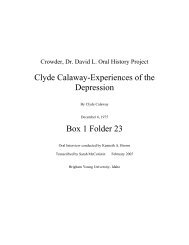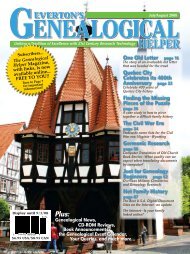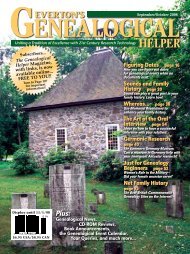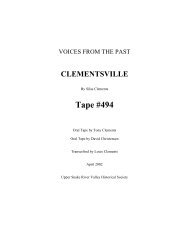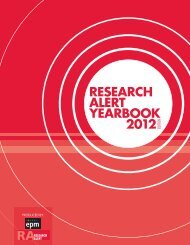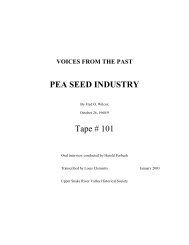HelPeR - BYU Idaho Special Collections and Family History
HelPeR - BYU Idaho Special Collections and Family History
HelPeR - BYU Idaho Special Collections and Family History
You also want an ePaper? Increase the reach of your titles
YUMPU automatically turns print PDFs into web optimized ePapers that Google loves.
On the Bookshelf<br />
Zweibrucken, <strong>and</strong> other principalities in southern<br />
Germany to settle in Pennsylvania between 1683 <strong>and</strong><br />
1776 <strong>and</strong> establish a new way of life in their adopted<br />
homel<strong>and</strong>. The author pinpoints the different waves<br />
of colonial Germans <strong>and</strong> Swiss <strong>and</strong> illustrates the<br />
pivotal roles played by such personalities as William<br />
Penn, Francis Daniel Pastorius, <strong>and</strong> Henry Melchior<br />
Muhlenberg in helping launch communities in Philadelphia,<br />
in Lancaster <strong>and</strong> Berks counties, <strong>and</strong> ultimately<br />
throughout Pennsylvania. The entire process<br />
of immigration is captured in vivid descriptions of<br />
(often unscrupulous) immigrant recruitment, the<br />
difficult passage across the Atlantic, indentured servitude,<br />
<strong>and</strong> settling on the l<strong>and</strong>. Most of these immigrants<br />
were farmers, <strong>and</strong> their customs <strong>and</strong> manners<br />
are recounted in an examination of housing, provisions,<br />
agricultural methods, superstitions, <strong>and</strong> so<br />
forth. There is a chapter on language, literature, <strong>and</strong><br />
education <strong>and</strong> a separate appendix on German family<br />
names. Perhaps the most informative chapter in<br />
the book covers the extraordinarily diverse religious<br />
life of these Protestant Germans, which, while dominated<br />
by the Lutheran <strong>and</strong> Reformed churches, also<br />
accommodated Moravians, Mennonites, Brethren,<br />
Dunkards, Seventh-Day Baptists, Schwenkfelders,<br />
<strong>and</strong> others. Concluding as it does with a chapter on<br />
the Revolution, in which we discover which Pennsylvania-Germans<br />
were patriots <strong>and</strong> which were<br />
pacifists, The German <strong>and</strong> Swiss Settlements of Colonial<br />
Pennsylvania is one volume that will hold the interest<br />
of Americans of colonial German descent from<br />
cover to cover.<br />
South Carolina<br />
Edgefield County, South Carolina<br />
Deed Books 42 <strong>and</strong> 43<br />
Abstracted by Carol Wells;<br />
2008; 5.5x8.5; 238 pp; softbound.<br />
Order from the publisher<br />
at: Heritage Books,<br />
Inc., 100 Railroad Ave.,<br />
Suite 104, Westminster, MD<br />
21157; Phone 800-876-6103;<br />
Fax 410-871-2674 or www.<br />
heritagebooks.com; W4509;<br />
ISBN: 078844509X; $24.50<br />
plus $7.00 p&h.<br />
The deed book abstracts<br />
in this volume were gleaned<br />
from documents that were recorded between 1826<br />
<strong>and</strong> 1829. In addition to the names, dates, <strong>and</strong> l<strong>and</strong><br />
descriptions one would expect to find in such records,<br />
these deed abstracts also reveal names of<br />
children <strong>and</strong> neighbors, ties to other areas, clues to<br />
family wealth (or lack of), names of wives, mothers,<br />
slaves, previous spouses, kinship, etc. These pages<br />
contain deeds of trust for protection of wives <strong>and</strong><br />
small children from a husb<strong>and</strong>’s financial troubles;<br />
prenuptial agreements; depositions; powers of attorney<br />
connecting different places; sheriff sales to partition<br />
estates or settle lawsuits, which often include<br />
the names of slaves. Chains of title reach back to the<br />
18th century original grantees <strong>and</strong> list the names of<br />
subsequent owners. The names of witnesses, adjoining<br />
l<strong>and</strong>owners, heirs, churches, branches, creeks,<br />
bridges, <strong>and</strong> ferries are included. The deeds are presented<br />
in original page number order with a full<br />
name index.<br />
People <strong>and</strong> Professions of Charleston,<br />
South Carolina 1782-1802<br />
By James W. Hagy; Originally<br />
printed in 1992; Reprinted<br />
2008; 5.5x8.5; 112 pp; softbound;<br />
indexed. Order from<br />
the publisher at: Clearfield<br />
Company, Inc., 3600 Clipper<br />
Mill Road, Suite 260, Baltimore,<br />
MD 21211; or www.<br />
genealogical.com; CF9135;<br />
ISBN: 9780806313238; $19.50<br />
plus $4.00 p&h.<br />
This publication affords<br />
us as close a glimpse of the<br />
population of Charleston, South Carolina during the<br />
last quarter of the 18th century as we are likely to<br />
come by. Professor Hagy has compiled all the names<br />
<strong>and</strong> other pertinent genealogical information that<br />
can be found in the Charleston city directories of<br />
1782, 1785, 1790, 1794, 1796, 1801, <strong>and</strong> 1802 <strong>and</strong> in<br />
the federal censuses for Charleston for 1790 <strong>and</strong><br />
1800. In assembling his data, the author has chosen<br />
to respect the integrity of his sources, thus the<br />
contents of each directory or census are arranged<br />
in a separate alphabetical sequence, preceded by a<br />
brief commentary concerning the methods used by<br />
the original compilers in producing the directory or<br />
census in question. In the case of the city directories,<br />
the names of inhabitants are followed by their occupations<br />
<strong>and</strong> addresses; for the censuses of 1790<br />
<strong>and</strong> 1800, only the names of the heads of household<br />
appear. Since a given individual may appear/disappear<br />
in as many as nine different listings spanning<br />
a 20-year period, the People <strong>and</strong> Professions of<br />
Charleston affords genealogists the rare opportunity<br />
of tracing the mobility or migration of a given ancestor<br />
at very close range. While this work cannot<br />
Ja n ua ry/Fe b r u a r y 2009 Ev e r t o n’s Ge n e a l o g i c a l He l p e r © 141



